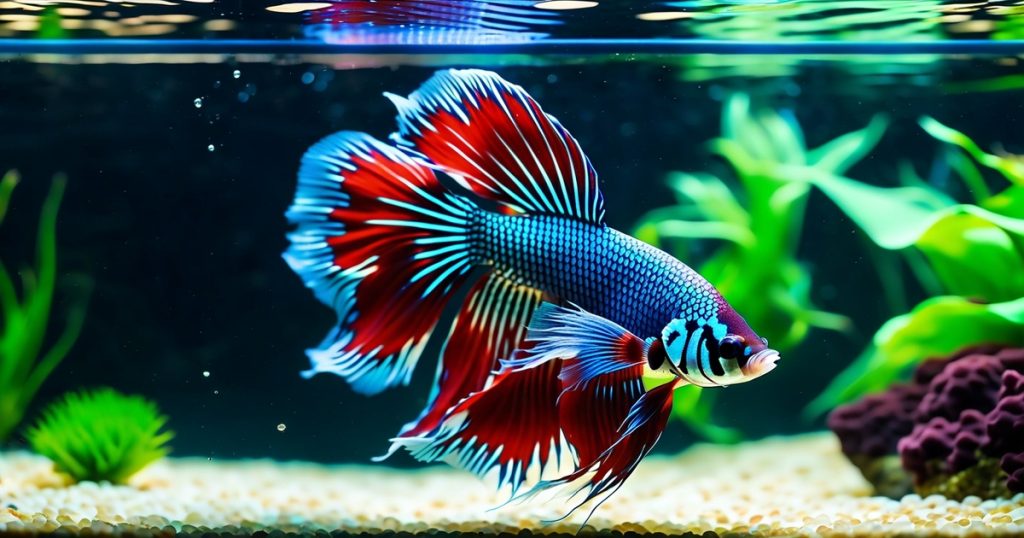Did you know that 80% of new betta fish owners encounter their pets hiding and refusing to eat? It can be concerning, but there’s no need to panic. When bringing home a new betta fish, it’s common for them to feel stressed in their new environment. Understanding the reasons behind this behavior is crucial in helping your pet adjust and thrive.
In this post, we’ll delve into the potential causes of your betta fish’s reclusive behavior and loss of appetite. We’ll also explore effective strategies to create a comfortable habitat and encourage healthy eating habits for your beloved aquatic companion.
Table of Contents
ToggleBetta Fish Hiding and Eating Patterns

Reasons for Hiding
Betta fish may hide when stressed or feeling threatened. New environments, aggressive tank mates, or inadequate hiding spots can stress bettas. If the tank lacks plants or caves, the fish might feel exposed and anxious. Loud noises or sudden movements near the tank can also cause stress.
Some bettas take time to adjust to new surroundings before eating. This is common after being transported from the pet store to a new home. The change in water conditions and temperature, and salt therapy can be unsettling for them. It’s crucial to provide a calm environment with plenty of hiding places so they feel secure.
Natural Behavior
Understanding natural betta behavior is essential in addressing hiding and eating issues. In their natural habitat, bettas live in shallow waters with lots of vegetation where they can hide from predators and find food easily. Recreating this environment in their aquarium with salt therapy helps reduce stress levels.
To help your betta overcome its shyness and start eating again, ensure that the tank has ample hiding spots like plants, caves, or decorations where it feels safe enough to come out of hiding to eat peacefully.
Factors Contributing to Betta Fish Stress and Hiding
Inadequate Tank Size
A small tank can cause stress in betta fish, leading them to hide and not eat. Bettas need space to swim freely and establish their territory. When they don’t have enough room, they may feel cramped and anxious, resulting in hiding behavior. For example, a betta fish kept in a tank that’s too small might spend most of its time hiding behind decorations or plants.
Another issue with an inadequate tank size is the lack of proper filtration and water circulation. This can lead to poor water quality, which further stresses the betta fish.
Aggressive Tank Mates
The presence of aggressive tank mates can also be a cause for bettas to hide and refuse food. Other fish or even certain species of snails may intimidate the betta, making it fearful and stressed. For instance, if there are fin-nipping fish in the same tank as the betta, it will likely retreat into hiding spots out of fear for its safety.
In addition to aggression from other aquatic creatures, excessive noise or movement near the aquarium can also contribute to stress-induced hiding behaviors in bettas.
Poor Water Quality
Poor water quality is another significant factor that can lead to stress-induced hiding behavior in bettas. Ammonia buildup due to infrequent cleaning or overfeeding can harm their health and well-being. This discomfort often prompts them to seek refuge by staying hidden among plants or under decorations within their habitat.
Importance of Proper Acclimation for New Betta Fish
Gradual Acclimation
Acclimating your new betta fish gradually can significantly reduce stress and help them feel more secure in their new environment. Bettas are sensitive creatures, and sudden changes in their surroundings can cause them to hide and refuse to eat. By slowly introducing them to their new tank, you allow them time to adjust without overwhelming them.
When you bring home a new betta fish, it’s essential to acclimate it by floating the bag in the tank water for about 15-20 minutes. This allows the water temperature inside the bag to gradually equalize with that of the aquarium. After this, you should add small amounts of tank water into the bag every 10-15 minutes until approximately an hour has passed.
Proper Temperature Matching
Maintaining proper temperature matching during acclimation is crucial for your betta’s health and well-being. Bettas thrive in warm waters ranging from 75°F (24°C) to 80°F (27°C). Sudden exposure to drastic temperature variations can shock your betta fish, leading to stress-induced hiding behavior and loss of appetite.
To ensure a smooth transition for your new betta, make sure that the temperature of the water in which they were transported matches closely with that of their new habitat before releasing them into their tank. Using a thermometer will help you monitor and maintain consistent temperatures throughout this process.
Creating a Comfortable Environment for Betta Fish
Providing Adequate Hiding Spots
Betta fish often hide when they feel stressed or overwhelmed. New bettas need time to adjust to their surroundings, and having hiding spots in the tank can make them feel more secure. Consider adding tank decorations like caves, tunnels, or small ceramic pots where your betta can retreat when feeling uneasy. These hiding spots mimic the natural habitat of bettas and provide them with a sense of security.
Placing live plants in the tank not only adds visual appeal but also serves as hiding places for betta fish. Plants like Java ferns, anubias, or marimo moss balls create a natural environment that helps reduce stress and anxiety in new bettas.
Maintaining Stable Water Temperature and Clean Water
Stress can cause betta fish to lose their appetite. To promote comfort and well-being, it’s crucial to keep the water temperature stable within the recommended range of 78-80°F (25-27°C). Fluctuating temperatures can lead to stress-related issues such as loss of appetite and lethargy.
Moreover, maintaining clean water is essential for betta fish health, as poor water quality can contribute to stress and illness. Regularly test the water parameters using a reliable test kit and perform partial water changes as needed to ensure optimal conditions for your new betta.
Managing Water Parameters for Betta Health
Importance of Regular Water Changes
Regular water changes are crucial for maintaining optimal water conditions for bettas. This helps remove toxins and waste that can build up in the tank, keeping the water clean and healthy for your fish. Without regular changes, harmful substances like ammonia can accumulate, posing a serious threat to your betta’s health.
It’s essential to monitor ammonia, nitrite, and nitrate levels in the aquarium. High levels of these compounds can be detrimental to your betta’s well-being, causing stress and potentially leading to illness. By regularly testing the water parameters using a reliable test kit, you can ensure that these levels remain within safe limits.
Maintaining Proper pH Levels
Proper pH levels are vital for the overall well-being of bettas. These fish thrive in slightly acidic water with a pH range between 6.5 and 7.5. Fluctuations outside this range can cause stress to your betta and compromise its immune system, making it more susceptible to diseases.
To maintain suitable pH levels, consider using products specifically designed to stabilize pH or naturally lower it through driftwood or Indian almond leaves. However, avoid drastic changes as sudden fluctuations in pH can also stress your betta.
Recognizing Signs of Sickness in Betta Fish
Changes in Fin Appearance
Changes in fin appearance can indicate illness in bettas. If you notice torn or ragged fins, it could be a sign that your fish has sustained injuries or is suffering from a health issue. Keep an eye out for any discoloration, rotting, or unusual growth on the fins as well.
Betta fish are known for their vibrant and flowing fins. Any deviation from their normal fin appearance might signal an underlying problem with their health. For instance, if you observe fraying or tearing of the fins, it’s essential to take prompt action to address the potential illness affecting your betta.
Loss of Appetite and Lethargy
A common sign of sickness in bettas is a noticeable loss of appetite accompanied by lethargy. If your new betta fish is hiding and not eating, it may be experiencing these symptoms which could indicate an underlying health issue.
When a normally active and voracious eater suddenly loses interest in food and becomes lethargic, it’s crucial to investigate further. This change often signifies that something isn’t right with your betta fish’s well-being.
Tips for Encouraging Your Betta to Eat and Be Active
Varied Diet
Offering a varied diet is crucial. Just like humans, bettas can get tired of eating the same thing every day. By introducing different types of food such as pellets, flakes, and live or frozen foods like brine shrimp or bloodworms, you can pique their interest in eating.
A varied diet not only keeps your betta excited about mealtime but also ensures that they are receiving all the necessary nutrients for good health. For example, feeding them high-quality pellets one day and frozen brine shrimp the next can help stimulate their appetite and prevent boredom.
Interactive Toys
Gentle encouragement through interactive toys can promote activity in bettas that seem to be hiding and inactive. Consider adding floating mirrors near their tank for short periods each day. This will encourage them to flare up and exercise their fins while interacting with their reflection.
Another great way to keep your betta active is by placing a ping pong ball in its tank. The movement of the ball mimics prey, encouraging your fish to swim around more frequently as if it were hunting.
When to Seek Veterinary Care for Your Betta
Refusal to Eat Despite Environmental Improvements
If your new betta fish is still hiding and not eating, despite making changes to its environment and feeding routine, it may be time to seek veterinary care. A persistent refusal to eat can indicate underlying health issues that require professional attention. Even after implementing the tips mentioned earlier, if your betta remains inactive and uninterested in food, consulting a vet becomes crucial.
It’s important to understand that while environmental improvements can often resolve minor issues causing stress or appetite loss in bettas, there are cases where medical intervention is necessary. If your efforts at creating an inviting habitat haven’t yielded positive results in terms of your betta’s eating habits and activity levels, it’s best not to delay seeking expert advice.
Severe Physical Symptoms
In addition to a lack of appetite and hiding behavior, severe physical symptoms like bloating or lesions on the betta fish should prompt immediate veterinary care. These signs could indicate serious health problems that need professional diagnosis and treatment. Waiting too long before seeking help for such visible symptoms can worsen the condition of your betta.
Remember that as a pet owner, you play a crucial role in ensuring the well-being of your betta fish. While trying out different strategies based on advice from reliable sources is commendable, recognizing when standard care measures aren’t yielding results is equally important. In such cases, reaching out to a veterinarian who specializes in aquatic animals will provide the best chance for understanding and addressing any underlying health concerns affecting your new betta fish.
Closing Thoughts
So, there you have it! Understanding why your new betta fish is hiding and not eating can be a bit tricky, but with the right knowledge and care, you can help your little buddy feel more at home. Remember, creating a comfortable environment, managing water parameters, and keeping an eye out for signs of sickness are all crucial in ensuring your betta fish’s well-being. Don’t hesitate to reach out to a vet if you notice something off – it’s always better to be safe than sorry.
Now, go put this newfound knowledge into action and give your betta fish the best care they deserve! Keep an eye on their behavior and make adjustments as needed. Your little aquatic pal will thank you for it. Happy fish-keeping!
